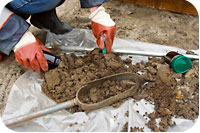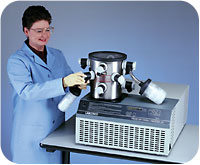Sediment Testing
ALS - Columbia specializes in the testing analysis of sediment, including from marine and freshwater. Much of our analytical work is in support of dredging, remedial investigation, feasibility studies and risk assessment. In many cases, this requires extremely low-level detection limits. These types of samples present unique challenges to the laboratory due to analytical interferences caused by the matrices. In addition to supporting marine and freshwater aquatic sample analyses throughout the United States, our laboratories also possess the necessary permits to accept samples from foreign countries.

ALS - Columbia has developed and implemented cleanup procedures and method modifications to specifically deal with these types of matrices. We have also developed the expertise necessary to perform complex ultra-trace analyses. These low-level analyses of sediment, tissue and water use advanced specialized instrumentation. This instrumentation includes Inductively Coupled Plasma Mass Spectroscopy (ICP/MS), purge and trap cold vapor atomic fluorescence spectrometry, High-Resolution Gas Chromatography/Mass Spectroscopy (HRGC/MS), and High-Resolution Gas Chromatography/High-Resolution Mass Spectrometry (HRGC/HRMS).
Following is information which provides a general description of ALS - Columbia's analytical protocols for determining trace analytes in marine and freshwater environmental samples. Detection limits for these analytes are also included. The analytes discussed are those typically requested for marine and freshwater projects.
Sediments Analytical Protocol

A brief description of the procedures ALS - Columbia typically employs for the analysis of sediment, tissue, seawater and freshwater matrices in support of marine and freshwater studies is provided in the following sub-sections. Due to the complexity of analyzing these matrices for low-level constituents, specialized procedures beyond the scope of EPA SW 846, EPA-CLP and other routine methods are often required. Seawater presents no particular challenges when determining organic constituents. However, trace metals analysis in the presence of high dissolved solids requires relatively involved techniques to reach the levels of detection typically required to meet project objectives. ALS - Columbia has been active in research and development of procedures for preparation and analyses of sediment, tissue and water samples. Our laboratory specializes in the analysis of tissue and sediment for low-level chemical constituents and has developed procedures for providing data of high technical quality that meets standard validation criteria. A summary of some of our experience over the last ten years may be found in the Marine SOQ.
Freeze-Drying

ALS - Columbia incorporates the use of freeze-drying of sediment and tissue samples for environmental analysis. Freeze-drying of sediment and tissue samples is performed prior to extraction and analysis for Polynuclear Aromatic Hydrocarbons (PAHs), Polychlorinated Biphenyls (PCBs), Pesticides, Dioxins, and Metals. The use of freeze-drying eliminates or reduces the undesirable effects of water. The most significant benefits are lower detection limits and more quantitative determinations. In addition to lower detection limits and better recoveries, freeze-drying of samples allows for complete homogenization of the sample matrices. Thus, improved precision is realized. This is particularly significant when analyzing heterogeneous samples (e.g. high organic sediments, whole-body tissues, etc.).
Polyaromatic Hydrocarbons (PAHs) and Base Neutral Acid Compounds (BNAs)
PAH Polyaromatic HydrocarbonsSample preparations are generally initiated using traditional solvent extraction techniques such as soxhlet, and, occasionally, sonication. Prior to instrumental analysis, extracts are put through GPC cleanup and usually silica gel cleanup. For PAHs, instrumental analysis is performed using Gas Chromatograph /Mass Spectrometry (GC/MS) operated in the Selective Ion Monitoring (SIM) mode to maximize sensitivity. In addition to the standard list of PAHs typically analyzed, the associated alkylated homologs are also available. For low-level semi-volatile organic analysis, conventional GC/MS techniques are used in conjunction with a Large Volume Injector (LVI) system. The LVI allows for a greater quantity of analyte to be introduced into the GC/MS than standard injection systems.
Learn more about PAH Testing...
Analytical testing dots
PCB Congeners
PCBTo obtain the low level detection limits required when analyzing marine sediments, the PCB congener analysis is performed by following EPA Method 8082 with slight modifications to the sample mass, final extract volume, and cleanup procedures. To accommodate the relatively large sample mass required to reach the low level detection limits, the samples are extracted using a sonication technique. The extracts are subjected to Gel Permeation Chromatography (GPC), mercury, silica gel, acid, and permanganate cleanups prior to Gas Chromatograph/Electron Capture DetectorGC/ECD analysis.
- Learn about Testing for PCB congeners...
- Learn about Testing PCB congeners by the CLP method...
- Learn about EPA method 1668A...
- Learn about EPA method 8082...
- Analytical testing dots
PCB Aroclors
PCB 81 Molecular StructureTo obtain the low level detection limits required when analyzing marine sediments, the pesticide and PCB Aroclor analyses are performed by following EPA Methods 8081 and 8082 with slight modifications to the sample mass, final extract volume, and cleanup procedures. To accommodate the relatively large sample mass required to reach the low level detection limits, the samples are extracted using a sonication technique. The extracts are put through GPC cleanup and mercury cleanup procedures prior to splitting for Aroclor and pesticide analyses. The pesticide fraction generally goes directly to the GC/ECD for analysis. The PCB Aroclor fraction receives an acid cleanup prior to GC/ECD analysis.
Organotins
Organotin CompoundBulk sediment samples are analyzed using solvent extraction, derivatization, and a GC/FPD. Samples are dried with muffled, anhydrous sodium sulfate. Following the addition of surrogate compounds (tripropyltin chloride and tripentyltin chloride), sediments are extracted with methylene chloride that contains 0.1% (wt./vol.) tropolone. After solvent exchange into hexane, extracts are derivatized with hexylmagnesium bromide in ether via a Grignard reaction. The Grignard reagent is synthesized by ALS - Columbia (commercially available reagent is not used due to unacceptable purity). Sediment extracts are cleaned by elution through alumina and silica gel columns. The extracts are analyzed by GC/FPD with a 610 nm filter. A minimum (10%) of analyte hits are confirmed by secondary column GC/FPD or GC/MS analysis. All detectable values are confirmed if the samples originated from an uncharacterized site (i.e., no historical data to suggest the likelihood of the presence of organotin).
Metals
Testing for MetalsSediment samples are prepared for analysis using one of two approaches. One procedure incorporates the use of hydrofluoric acid to assure dissolution of refractory compounds and/or refractory compounds containing heavy metals (i.e., contained within the crystalline structure). In recent years, this approach has almost been eliminated for marine studies conducted for environmental applications. Currently, the digestion procedure most commonly required consists of a more traditional nitric/peroxide dissolution essentially equivalent to the EPA soil procedures. ALS - Columbia performs both procedures. The analysis of the digestate for trace constituents is typically performed using ICP-MS. Major components are analyzed using ICP-Optical Emission Spectrometry (OES). Sediment samples generally present no analytical difficulties with regard to uncorrectable interferences. Occasionally, Graphite Furnace Atomic Absorption Spectrophotometry (GFAAS) is needed for confirmation of some elements.
For mercury, a larger aliquot of the wet sample is digested than is usually done for routine analyses of solid and semi-solid materials. This allows representative sub-sampling of sediments and provides the additional sensitivity typically required. The digestion procedure incorporates similar ratios of digesting/oxidizing reagents as standard EPA procedures. Additional concentrated nitric is added to facilitate the digestion of the high organic content. Standard Cold Vapor Atomic Absorption Spectrophotometry (CVAAS) technique is used for the analysis of the digestate.
Dioxins/Furans
Dioxin Molecular StructureALS - Columbia follows EPA Methods 8280, 8290, and 1613 to perform dioxin/furan analyses. EPA Methods 8290 and 1613 require high resolution gas chromatography/high resolution mass spectrometry (HRGC/HRMS) techniques to meet the parts per trillion (sediment) detection limits typically requested. The reporting limits are listed in the tables following page 13 of the Marine SOQ. In order to reach these ultra-low detection limits, extensive procedures were developed to minimize contamination. These procedures minimize sample transfer and use disposable glassware where feasible. Special clean-up techniques have been specifically developed for sediment to minimize matrix interferences.